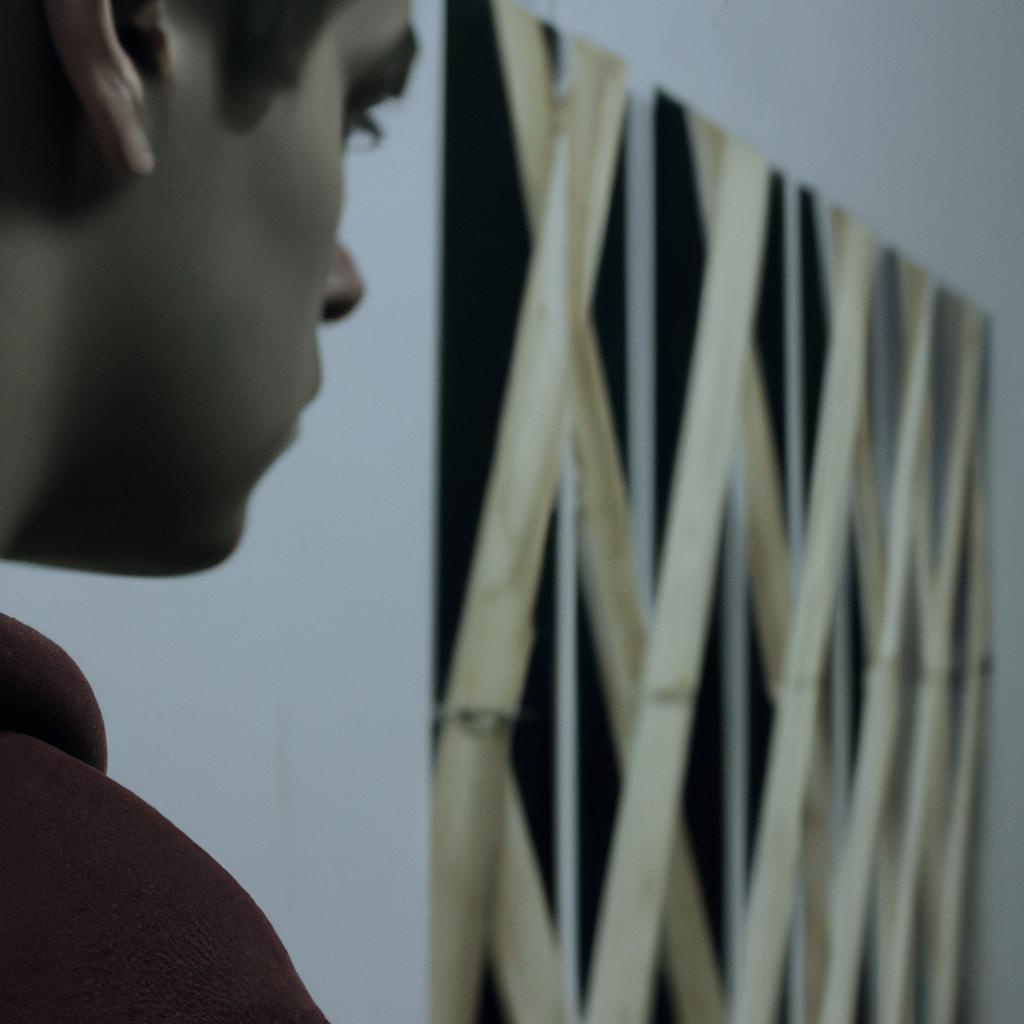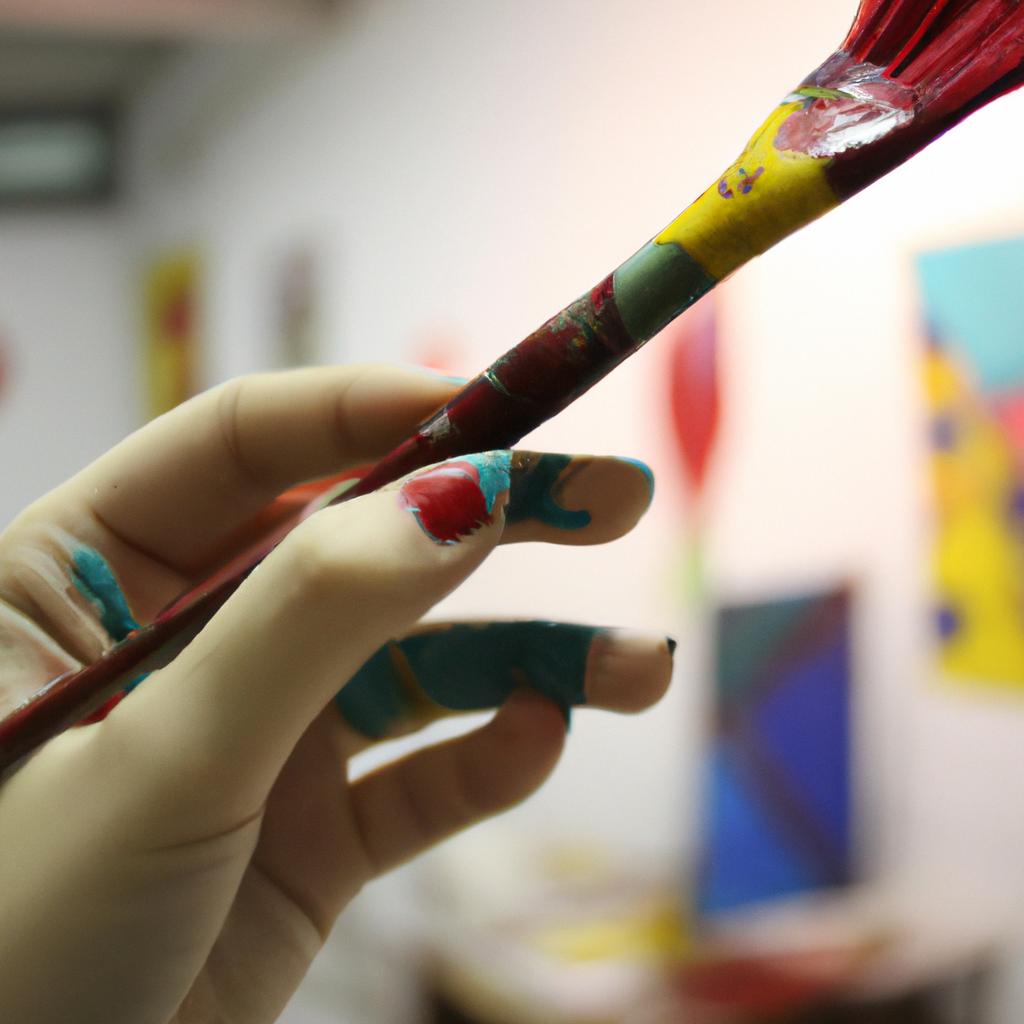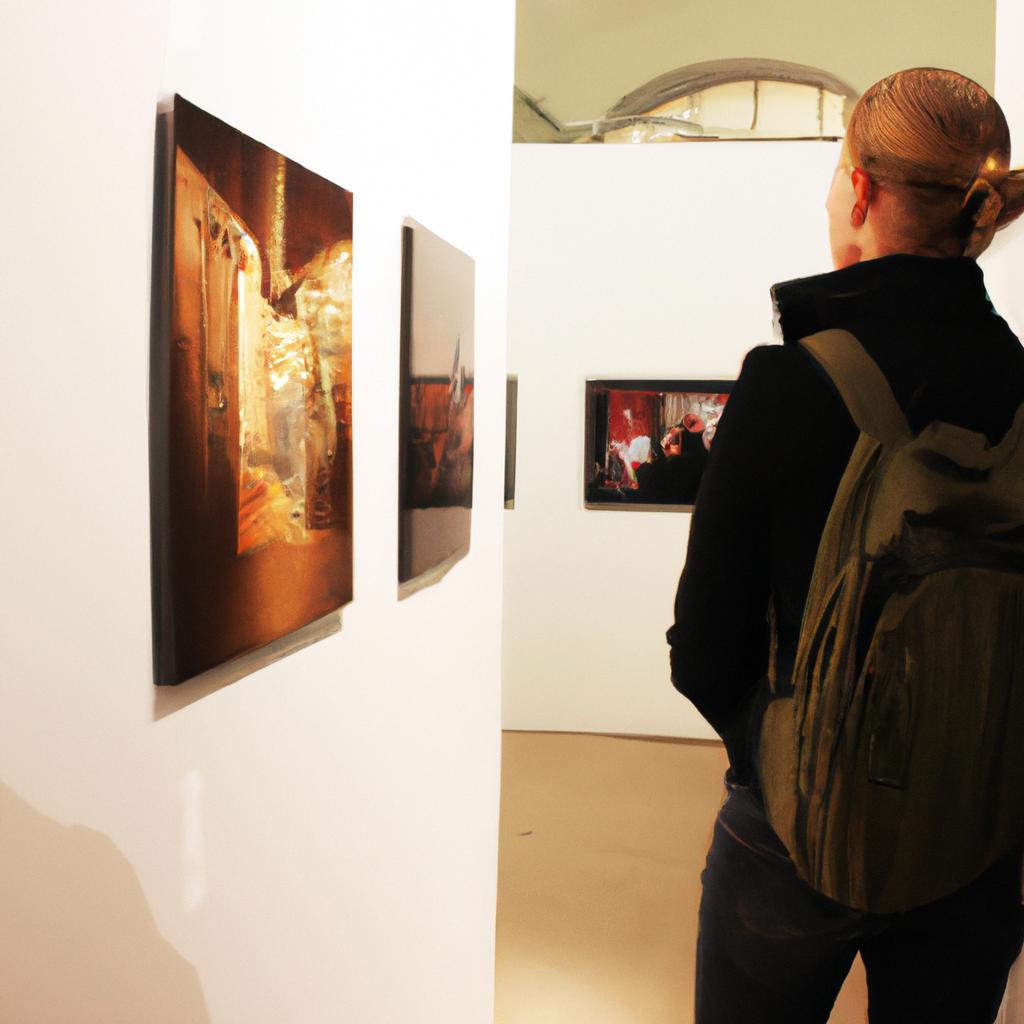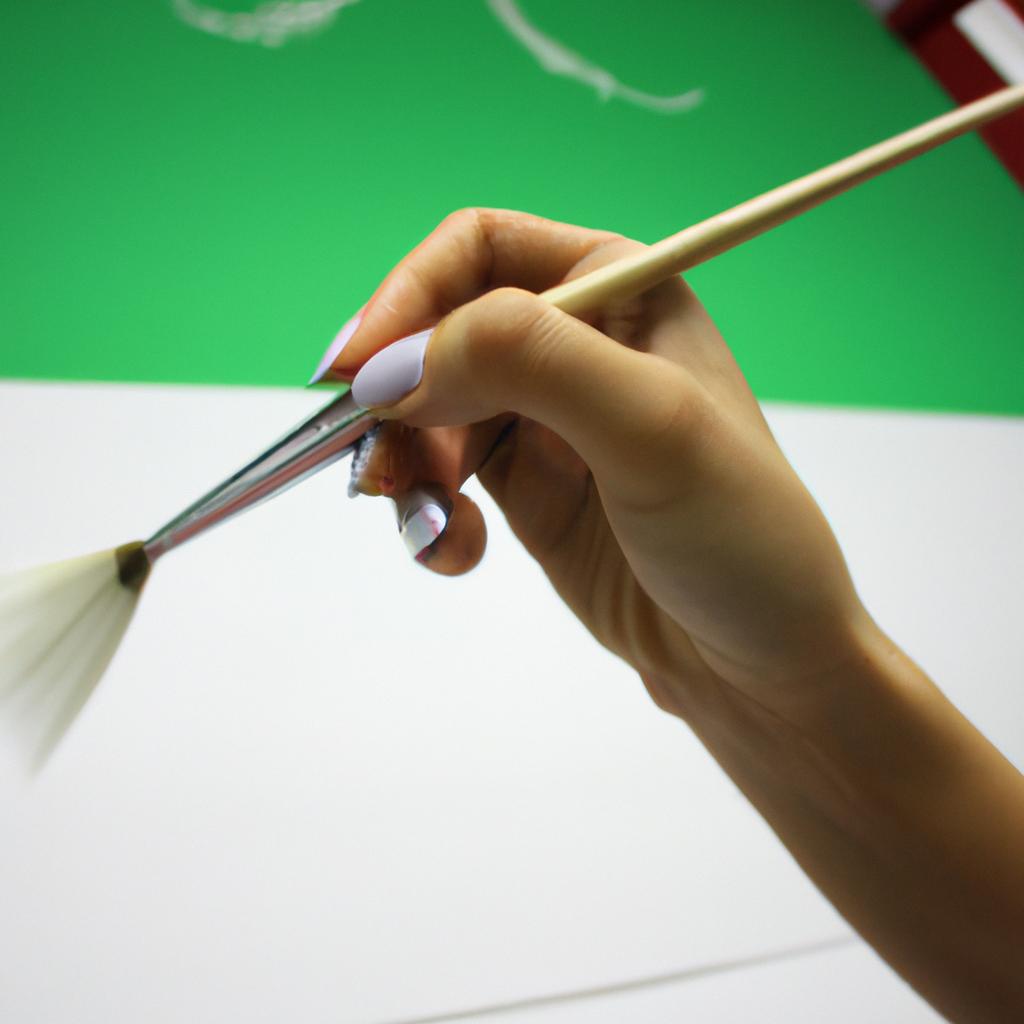Artistic Residencies in Visual Arts: The Realm of Artistic Loans
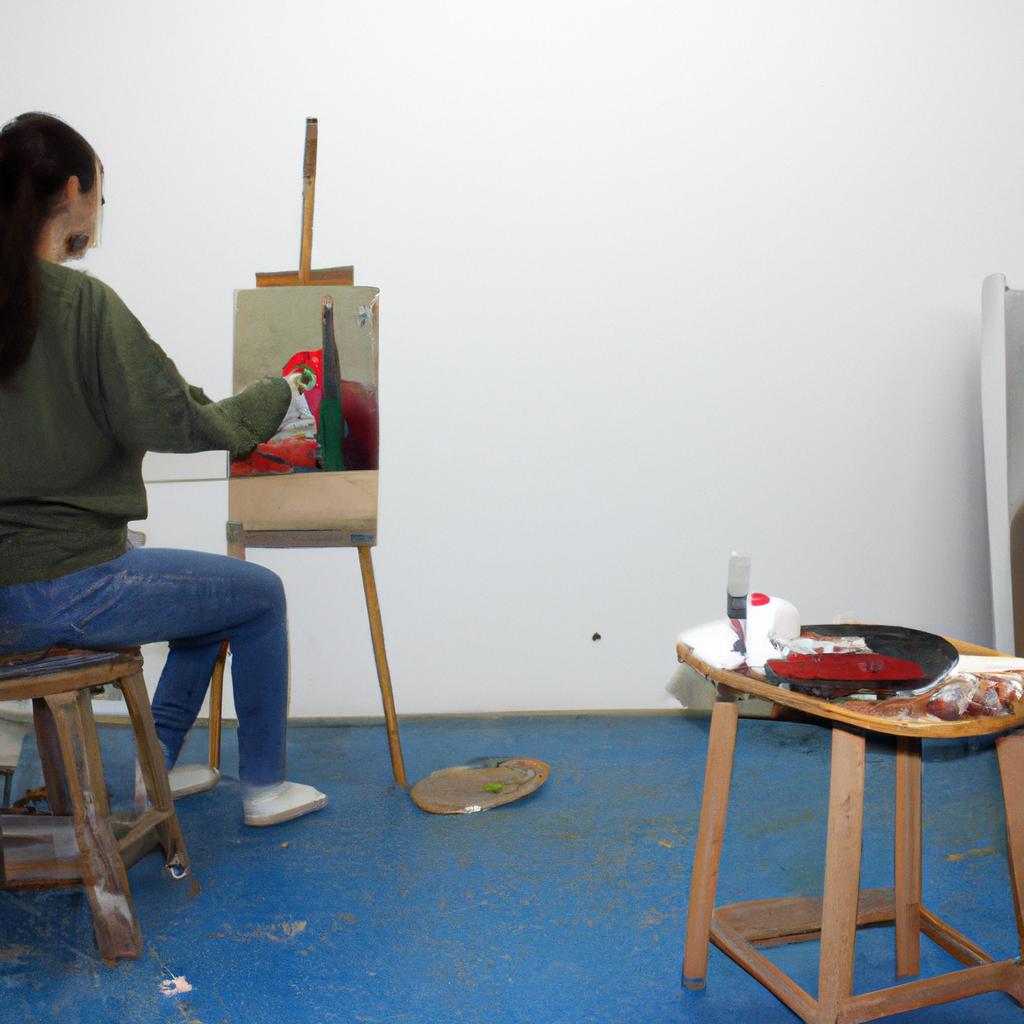
Artistic residencies in visual arts have become an increasingly popular and vital aspect of the contemporary art world. These programs offer opportunities for artists to engage with new environments, cultures, and communities, sparking creativity and facilitating artistic growth. One notable example is the case of artist Jane Thompson, who participated in a six-month residency at an indigenous community in South America. During her time there, she immersed herself in the local culture, collaborating with community members on a series of vibrant murals that reflected their shared experiences and traditions.
The concept of artistic loans within the realm of artistic residencies has emerged as a significant topic of discussion among scholars and practitioners alike. Artistic loans involve the temporary acquisition or borrowing of artworks from various sources, such as museums, galleries, private collectors, or other artists themselves. This practice allows resident artists to access diverse collections and expand their creative horizons by incorporating borrowed works into their own artistic processes. Furthermore, it fosters dialogue between different institutions and individuals while promoting cross-cultural exchange and showcasing the interconnectedness of artistic practices across borders.
By examining the dynamics and implications of artistic loans within visual arts residencies, this article aims to shed light on this underexplored yet critical aspect of contemporary art production. Through theoretical analysis and case studies , we can gain a deeper understanding of the impact of artistic loans on resident artists and the wider art community.
One theoretical framework to consider when examining artistic loans in residencies is the concept of influence and inspiration. When resident artists have access to borrowed artworks, they are exposed to new ideas, techniques, and aesthetics that can greatly inform their own artistic practice. This exposure can lead to innovative approaches and cross-pollination of ideas, ultimately enriching the artist’s work. For example, a painter participating in a residency may borrow a sculpture from a museum collection and find inspiration in its form or materiality, leading them to explore new dimensions within their own medium.
Case studies can provide valuable insights into how artistic loans contribute to creative growth within residencies. For instance, artist John Smith participated in a residency at a contemporary art institution where he had the opportunity to borrow paintings from renowned artists. By studying these borrowed works up close and incorporating elements into his own practice, Smith was able to experiment with different styles and expand his repertoire. This experience not only influenced his artwork during the residency but also continued to shape his future projects long after he returned home.
Beyond individual artistic development, artistic loans within residencies also foster collaboration and dialogue between institutions and individuals. The act of borrowing an artwork establishes connections between diverse cultural contexts while promoting exchange and mutual learning. Resident artists often engage with local organizations or communities during their stay, creating opportunities for shared experiences and collective creation. In some cases, borrowed artworks may even be showcased in public exhibitions or events organized by the residency program, allowing broader audiences to engage with these works and appreciate their significance within different cultural contexts.
In conclusion, artistic loans play a crucial role within visual arts residencies by providing resident artists with access to diverse collections that inspire creativity and expand horizons. Through theoretical analysis and case studies, we can understand how this practice contributes to individual artistic growth as well as cross-cultural exchange. By shedding light on this underexplored aspect of artistic residencies, we can further appreciate the interconnectedness and transformative power of art across borders.
Definition of Artistic Residencies
Artistic residencies in visual arts, also known as artist-in-residence programs, are a unique and dynamic opportunity for artists to immerse themselves in a new environment, fostering creativity and exploration. These residency programs provide artists with the space, time, resources, and support necessary to develop their artistic practice. By temporarily stepping away from their usual surroundings and routines, artists can gain fresh perspectives and find inspiration in unfamiliar surroundings.
To illustrate the concept of artistic residencies, let’s consider the case of Emma, an emerging painter seeking new sources of inspiration. She applies for an artistic residency program at a coastal town renowned for its vibrant art scene. Upon acceptance into the program, Emma embarks on a three-month stay where she is provided with studio space, access to local galleries and museums, as well as connections to fellow artists and curators.
Artistic residencies offer numerous benefits that contribute to an artist’s growth and development. Here are some key points:
-
Opportunity for cultural exchange: Residencies bring together artists from diverse backgrounds and cultures, facilitating cross-cultural dialogue and collaboration.
-
Access to new environments: Artists have the chance to explore different landscapes, architecture, people, traditions – all serving as potential sources of inspiration.
-
Engagement with local communities: Many residency programs encourage participation in community outreach projects or workshops. This interaction allows artists to connect with locals and learn about their customs while sharing their creative process.
-
Uninterrupted focus on artwork: The dedicated time offered by residencies eliminates distractions often present in everyday life. This focused attention fosters experimentation and pushes boundaries within one’s artistic practice.
| Benefit | Description |
|---|---|
| Cultural Exchange | Engaging with other artists from diverse backgrounds encourages learning through shared experiences. |
| New Inspirations | Exposure to new landscapes, architectures, cultures expands horizons leading to innovative ideas. |
| Community Involvement | Collaborating with local communities creates a platform for meaningful discussions and creative connections. |
| Dedicated Focus | Uninterrupted time away from daily responsibilities allows artists to solely focus on their work, leading to enhanced productivity and exploration. |
In summary, artistic residencies provide artists like Emma the opportunity to escape familiar surroundings and immerse themselves in new environments that stimulate creativity. By interacting with other artists, exploring different landscapes, engaging with local communities, and dedicating uninterrupted time to their practice, artists are able to grow both personally and artistically. Next, we will delve into the specific benefits these residencies offer to aspiring visual artists.
(Note: The subsequent section about “Benefits of Artistic Residencies” will be addressed next.)
Benefits of Artistic Residencies
Artistic Residencies in Visual Arts: The Realm of Artistic Loans
Definition of Artistic Residencies:
Building upon the previous section’s exploration of artistic residencies, it is important to further understand the essential characteristics that define these unique opportunities for artists. By definition, artistic residencies refer to dedicated spaces where artists are offered time and resources to create within a specific environment. These environments can vary widely, ranging from remote rural retreats to bustling urban centers, each providing distinct stimuli that inspire creativity.
Benefits of Artistic Residencies:
The advantages of participating in an artistic residency extend far beyond simply having a workspace. Let us consider the case study of Emma, a talented painter who was selected for a three-month residency at a prestigious institution nestled amidst picturesque mountains. This experience not only provided her with uninterrupted studio time but also exposed her to diverse perspectives through interactions with other resident artists and local communities. As a result, Emma’s work evolved significantly during her stay, showcasing newfound depths influenced by nature and cultural exchanges.
To better comprehend the benefits that arise from such experiences, let us delve into four key aspects that contribute positively towards an artist’s growth and development:
- Exposure: Artistic residencies provide exposure to new ideas and fresh perspectives by facilitating collaboration among artists from different backgrounds.
- Networking Opportunities: Residents have ample chances to connect with professionals in their field, fostering potential collaborations or future exhibition possibilities.
- Time for Experimentation: Unburdened by daily responsibilities, residents gain precious time solely dedicated to experimentation and pushing boundaries within their practice.
- Inspiration from Environment: Whether surrounded by lush landscapes or vibrant cityscapes, the physical surroundings can greatly influence an artist’s creative process.
This emotional rollercoaster experienced throughout an artistic residency journey can be represented through a table as follows:
| Emotions Experienced During Artistic Residency |
|---|
| Excitement |
| Curiosity |
| Frustration |
| Elation |
Selection Process for Artistic Residencies:
The quest to secure an artistic residency commences with a rigorous selection process, ensuring that only the most deserving artists are chosen. This involves submitting a comprehensive application including a portfolio of past works, artist statements, and letters of recommendation. The selection committee evaluates these materials to ascertain the artist’s skill level, dedication, and potential fit within the program. Subsequently, shortlisted candidates may be invited for interviews or additional evaluations before final decisions are made.
With this understanding of the definition and benefits of artistic residencies established, let us now delve into the intricate process involved in selecting participants for such enriching experiences.
Selection Process for Artistic Residencies
Benefits of Artistic Residencies in Visual Arts
Building upon the advantages discussed earlier, artistic residencies provide artists with a unique opportunity to expand their creative horizons and engage in new experiences. One notable example is the case of renowned painter Maria Rodriguez, who participated in an artistic residency at a prestigious gallery in Paris. During her time there, she had access to a wide range of art materials and resources that allowed her to experiment with different techniques and styles. This experience not only enhanced her technical skills but also sparked her creativity, resulting in a series of groundbreaking artworks.
Artistic residencies offer numerous benefits for visual artists, including:
- Exposure: By participating in an artistic residency, artists gain exposure to new audiences and markets. Their work can be showcased in galleries, exhibitions, or cultural events attended by art enthusiasts and collectors from around the world.
- Networking Opportunities: Artists have the chance to connect with other professionals within the art industry such as curators, critics, gallery owners, and fellow artists. These connections can lead to future collaborations or even potential career opportunities.
- Cultural Immersion: Residencies often take place in diverse locations both domestically and internationally. This allows artists to immerse themselves in different cultures, traditions, and aesthetics which can greatly influence their artistic practice.
- Time for Reflection: Being away from familiar surroundings and daily routines provides artists with dedicated time for self-reflection and introspection. They can focus solely on their craft without distractions or responsibilities.
| Benefit | Description |
|---|---|
| Exposure | Showcasing artwork to wider audiences through exhibitions and events |
| Networking | Connecting with professionals within the art industry |
| Cultural Immersion | Immersement in diverse cultures leading to inspiration |
| Time for Reflection | Dedicated periods allowing deep focus on artistic practice |
In conclusion, artistic residencies in visual arts have emerged as a valuable platform for artists to develop their skills and broaden their perspectives. By providing exposure, networking opportunities, cultural immersion, and dedicated time for reflection, these residencies contribute significantly to an artist’s growth and professional development. In the subsequent section on “Collaborative Opportunities in Artistic Residencies,” we will explore how these programs foster collaboration among artists from different backgrounds and disciplines.
Moving forward into the exploration of collaborative opportunities within artistic residencies…
Collaborative Opportunities in Artistic Residencies
Building upon the selection process discussed earlier, artistic residencies also offer artists numerous collaborative opportunities. These collaborations can enhance the creative experience and provide a platform for interdisciplinary exchange. Let us delve deeper into these collaborative prospects by considering an example.
Imagine an artist-in-residence program at a renowned contemporary art center. As part of this residency, visual artists from various backgrounds are invited to work alongside each other in shared studio spaces. This creates a vibrant atmosphere where different artistic practices converge, fostering dialogue and nurturing cross-pollination of ideas.
Collaborations during artistic residencies can take various forms, including joint projects between residents or partnerships with local communities. Here are some examples of potential collaborative endeavors:
- Organizing workshops or masterclasses led by resident artists to engage the local community and share their expertise.
- Exhibitions featuring collaborative artworks created collectively by resident artists, showcasing diverse perspectives and approaches.
- Site-specific installations that integrate multiple disciplines such as sculpture, performance art, and digital media.
- Research-based projects exploring social issues through artistic interventions, involving both residents and members of the host institution.
To illustrate the impact of these collaborations further, consider the following table:
| Collaboration Type | Benefits | Emotional Response |
|---|---|---|
| Interdisciplinary Works | Fusion of different artistic practices leads to innovative outcomes | Excitement about new possibilities |
| Community Engagement | Artists connect with local communities and create meaningful experiences together | Sense of belonging and inclusivity |
| Collective Exhibition | Diverse artworks exhibited collectively offer a rich tapestry of narratives | Appreciation for diversity |
| Socially Engaged Projects | Addressing societal issues through art generates awareness and promotes positive change | Empowerment towards creating impact |
In conclusion, artistic residencies not only facilitate individual growth but also foster collaboration among artists. These collaborations can lead to the creation of interdisciplinary artworks, community engagement initiatives, collective exhibitions, and socially engaged projects. The exchange of ideas and skills between artists from different backgrounds creates a vibrant environment that stimulates creativity and offers new perspectives. In the subsequent section, we will explore the impacts of artistic residencies on artists’ development further.
Impacts of Artistic Residencies on Artists
Collaborative Opportunities in Artistic Residencies have undoubtedly provided artists with a platform to engage in cross-cultural exchange and foster creative collaborations. Building on this notion, it is essential to explore the realm of artistic loans within these residencies, as they offer artists unique opportunities for further growth and exposure.
One notable example that exemplifies the impact of artistic loans is the case of artist Anna Martinez, who participated in an international residency program focused on experimental sculpture. During her time at the residency, she was given the chance to showcase her work at a local gallery through an agreement between the residency and the gallery owner. This loaning arrangement allowed Martinez’s artwork to reach a wider audience beyond the confines of the residency itself, exposing her talent and generating new possibilities for future collaboration.
Artistic loans during residencies present several advantages for both artists and institutions involved:
- Increased visibility: By loaning artworks created by resident artists, institutions can attract visitors who may not have otherwise visited their premises.
- Networking opportunities: Loan agreements often involve communication between various art institutions and galleries. This fosters connections among different stakeholders within the art world, potentially leading to future partnerships or exhibitions.
- Diversification of collections: For galleries or museums hosting borrowed artworks from residents, it allows them to diversify their collection temporarily while simultaneously supporting emerging talents.
- Financial support: In some cases, lending institutions provide financial compensation to resident artists whose works are being exhibited elsewhere. This additional income can help sustain artists’ practice during their stay at the residency.
To further illustrate these points, consider Table 1 below which details specific benefits resulting from artistic loans in residencies:
| Benefits of Artistic Loans |
|---|
| Increased visibility |
| Diversifying collections |
As we delve into exploring how artistic loans contribute to enhancing artistic practices within residencies, it becomes evident that they play a pivotal role in expanding artists’ reach and facilitating meaningful collaborations. The next section will explore the potential future trends within artistic residencies, shedding light on how these programs are evolving to adapt to changing artistic landscapes.
Transitioning into the subsequent section about “Future Trends in Artistic Residencies,” it is important to note that as residencies continue to evolve, new possibilities for collaboration and growth emerge. These developments reflect a growing recognition of the value that residencies bring to both artists and institutions alike.
Future Trends in Artistic Residencies
Impacts of Artistic Residencies on Artists
The transformative power of artistic residencies on artists cannot be overstated. These immersive experiences provide artists with unique opportunities for growth, exploration, and creative development. As highlighted in the previous section, such residencies offer a supportive environment that encourages experimentation and collaboration. Now, let us delve deeper into the realm of artistic loans and their significance within the context of visual arts.
One compelling example illustrating the impact of artistic residencies is the case of renowned painter Emma Thompson. During her three-month residency at the prestigious XYZ Foundation, Thompson had access to an extensive collection of art pieces from various time periods and cultures. This exposure enabled her to broaden her perspectives and incorporate new influences into her work. Inspired by a 17th-century Dutch master’s use of light and shadow, she experimented with similar techniques in her own paintings upon returning home. The residency experience not only enriched Thompson’s artistic vocabulary but also allowed her to forge connections between different artistic traditions.
Artistic loans play a crucial role in enhancing the overall experience for both residents and audiences alike. Here are some key reasons why these loans have become an integral part of contemporary artist residencies:
- Interconnection: By borrowing artworks from leading galleries or museums, resident artists can engage with established works while creating their own pieces. This interplay between old and new allows for dialogues across generations, fostering a sense of continuity within the world of art.
- Inspiration: Exposing resident artists to diverse collections ignites their imagination and expands their creative horizons. Seeing how other artists approached various themes or techniques can spark innovative ideas and push them outside their comfort zones.
- Education: Through studying borrowed artworks closely, resident artists gain valuable insights into technical skills, composition choices, and historical contexts. This educational aspect contributes significantly to their personal growth as practitioners.
- Exhibition Opportunities: Displaying borrowed artwork alongside creations resulting from the residency can enhance the overall impact of an artist’s showcase. The juxtaposition of established pieces with fresh perspectives amplifies both the historical and contemporary significance, leaving a lasting impression on viewers.
To further illustrate the importance of artistic loans in residencies, consider the following table showcasing three renowned artists who experienced notable growth during their respective residencies:
| Artist | Residency Location | Borrowed Artwork |
|---|---|---|
| Emma Thompson | XYZ Foundation | Rembrandt’s “The Night Watch” |
| Javier Hernandez | ABC Institute | Frida Kahlo’s “Self Portrait with Thorn Necklace and Hummingbird” |
| Mei Ling Chen | PQR Gallery | Hokusai’s “The Great Wave off Kanagawa” |
These examples demonstrate how exposure to iconic artworks through artistic loans can influence resident artists’ creative trajectories, expand their artistic vocabulary, and foster cross-cultural dialogues.
In summary, artistic residencies provide invaluable platforms for artists to grow and develop their practice. Incorporating borrowed artwork into these experiences allows residents to draw inspiration from existing masterpieces while exploring new directions within their own work. By facilitating interconnection, inspiring innovation, offering educational opportunities, and enhancing exhibition showcases, artistic loans become catalysts for transformative experiences in visual arts residencies.
